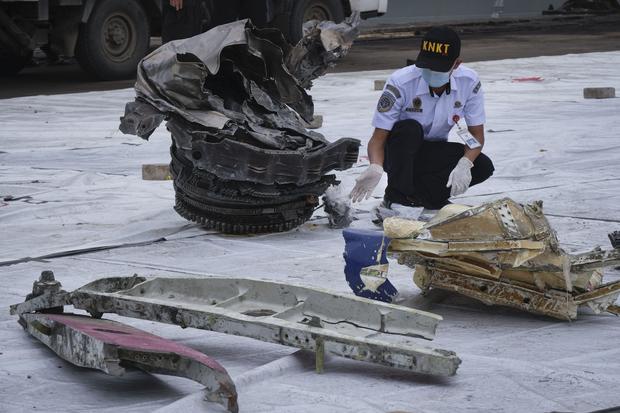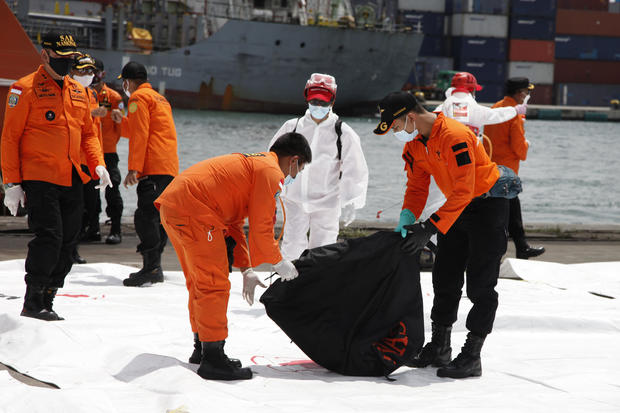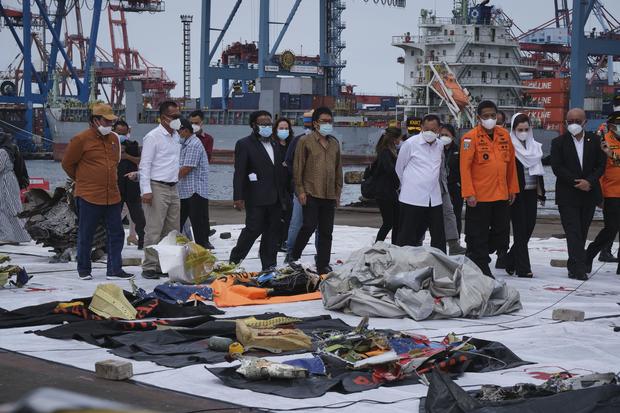[ad_1]
Jakarta, Indonesia — The search for the black boxes of a crashed Sriwijaya Air jet intensified Monday to boost the investigation into what caused the plane carrying 62 people to nosedive at high velocity into the Java Sea. The Boeing 737-500 jet disappeared minutes after taking off from Jakarta, Indonesia’s capital, during heavy rain on Saturday, and the search so far has yielded plane parts and human remains but no sign of survivors.
Authorities have said signals from the boxes containing the cockpit voice and flight data recorders were detected between two islands in the Thousand Island chain just north of Jakarta’s coast. Officials said they marked a location where the sounds were being emitted from the black boxes, which detached from the tail of the aircraft when it plummeted into the sea.
ED WRAY/Getty
The cockpit voice recorder holds conversations between pilots, and the data recorder tracks electronic information such as airspeed, altitude and vertical acceleration. When found, they will be transported to port and handed to the National Transportation Safety Committee overseeing the crash investigation.
The search
More than a dozen helicopters, 53 navy ships, 20 boats and 2,600 rescue personnel have been searching since Sunday and have found parts of the plane in the water at a depth of 75 feet, leading rescuers to continue searching the area.
Television coverage showed landing gear, wheels and a jet engine among the parts found, while other rescuers brought a dozen body bags containing human remains to a police hospital in eastern Jakarta for the identification process.
Aditya Irawan/NurPhoto/Getty
The National Search and Rescue Agency chief Bagus Puruhito said divers using high-tech “ping locator” equipment were looking for an identified target beneath 65 feet of seabed mud.
Video from the underwater search efforts, released later Monday by the search and rescue agency, shows divers inspecting large pieces of debris in the mud, as murky water swirls around them.
The investigation
The transport committee’s chairman, Soerjanto Tjahjono, said the black boxes could provide valuable information to investigators. Once the devices are found and taken to the investigators’ facility, it will take three to five days to dry and clean them and download the data, Tjahjono said.
He said more time could be required to analyze the information, “depending on the complexity of the problem.”
The committee’s investigator Nurcahyo Utomo said they had collected recordings and transcripts of the conversation between the pilot and air traffic controllers as part of their investigation into the cause of the crash.
ED WRAY/Getty
Utomo said his team was still examining radar data on the plane’s movements and had interviewed the air traffic officers who were in charge of the ill-fated flight. More interviews of witnesses, including with the airlines’ technicians, fishermen and experts were to be carried out in the near future.
Investigators were scrutinizing all the parts of the plane found by searchers on the seafloor, including the Ground Proximity Warning System, a device that can warn the pilot if the plane is too close to the ground, a radio altimeter and several other parts mostly from the lower side of the aircraft’s tail, Utomo said.
He said Singapore’s Transport Safety Investigation Bureau would help his committee in searching for the black boxes and the United States’ National Transportation Safety Board would join in investigating the crash.
Indonesia’s air transport record
Indonesia, the world’s largest archipelago nation, with more than 260 million people, has been plagued by transportation accidents on land, sea and air because of overcrowding on ferries, aging infrastructure and poorly enforced safety standards.
In October 2018, a Boeing 737 MAX 8 jet operated by Lion Air plunged into the Java Sea just minutes after taking off from Jakarta, killing all 189 people on board. The plane involved in Saturday’s disaster did not have the automated flight-control system that played a role in the Lion Air crash and another crash of a 737 MAX 8 jet in Ethiopia five months later, leading to the grounding of the MAX 8 for 20 months.
The Lion Air crash was Indonesia’s worst airline disaster since 1997, when 234 people were killed on a Garuda airlines flight near Medan on Sumatra island. In December 2014, an AirAsia flight from the Indonesian city of Surabaya to Singapore plunged into the sea, killing 162 people.
Sriwijaya Air has had only minor incidents in the past, though a farmer was killed in 2008 when a plane went off the runway while landing due to a hydraulic issue.
The United States banned Indonesian carriers from operating in the country in 2007, but reversed the decision in 2016, citing improvements in compliance with international aviation standards. The European Union has previously enforced similar bans, but lifted them in June 2018.
[ad_2]
Source link


